
Rhizoprionodon porosus
This small requiem shark is often confused with the Atlantic sharpnose shark (Rhizoprionodon terraenovae) so much so that the two were only recently distinguished as different species. These small sharks are considered harmless to humans.
Order: Carcharhiniformes
Family: Carcharhinidae
Genus: Rhizoprionodon
Species: porosus
Common Names
- English: Caribbean sharpnose shark, Atlantic sharpnose shark, sharpnose shark, snook shark
- Dutch: Caribische scherpsnuithaai
- Finnish: nokkahai
- French: requin aiguille antillais
- Papiamento: tribon cabez largu, tribon mula
- Portuguese: cação, cação-frango, frango
- Spanish: cazón de ley, cazon picudo, tollito, tollo hocicón
Importance to Humans
There is a limited commercial fishery for this species along the coast of Brazil. It is also caught in the artisan fisheries of Central America. It is caught with hook and line or longline, as well as bycatch in shrimp trawls and is often considered a nuisance by fishers. The flesh is marketed salted or frozen for human consumption, as well as processed into fish meal (Compagno, 1984).
The Caribbean sharpnose shark adapts to captivity and is successfully kept in large public aquariums.
Danger to Humans
This shark is considered harmless to humans primarily due to its small size and preference for small prey items. It avoids contact with humans and is difficult to approach while diving.
Conservation
The IUCN lists this species as “Least concern”. No conservation actions have been needed for this species.
> Check the status of the Caribbean sharpnose shark at the IUCN website.
The IUCN is a global union of states, governmental agencies, and non-governmental organizations in a partnership that assesses the conservation status of species.
Geographical Distribution
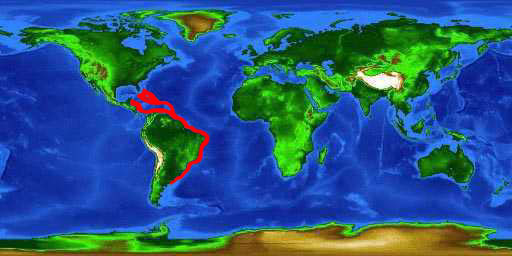
Limited in distribution to the western Atlantic Ocean. Found from the Caribbean region, including the Bahamas, to the south in Uruguay (Compagno, 1984).
Habitat
This locally abundant shark resides close inshore, primarily in tropical bays and estuaries with occasional forays into freshwater rivers. It is also reported to live in offshore waters to depths of 500 m (1,640 ft.), although more commonly seen in depths less than 100 m (328 ft.) (Compagno, 1984).
Biology

Distinctive Features
Slender fusiform body and long snout. The long labial furrows are present around the corners of the mouth. The first dorsal fin is typically over or just behind the free tips of the pectoral fins; the origin of the second dorsal fin is either just over the anal fin midbase to over the rear quarter of its base. The anterior margin of the pectoral fins is usually a bit longer than the first dorsal length from origin to free rear tip. The origin of the anal fin is anterior to the second dorsal fin origin. The margin of the anal fin is either straight or slightly concave (Compagno, 1984).
The similar smalltail shark (Carcharhinus porosus) can be distinguished from the Caribbean sharpnose shark by its serrated teeth as well as the absence of long labial furrows.
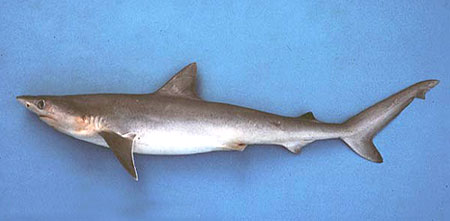
As the northern reaches of the Caribbean sharpnose shark’s range overlaps with the a very similar, closely related species, the Atlantic sharpnose shark (Rhizoprionodon terraenovae). These sharks can be distinguished only by the number of precaudal vertebrae with the Caribbean sharpnose shark having 65-75 precaudal vertebrae while the Atlantic species has only 58-65 precaudal vertebrae.
Coloration
The upper surface of the body is brown or grayish-brown in color, fading to a white underside. Occasionally, this shark will be marked with white spots along the flank region. The fins have either white or clear margins (Compagno, 1984).
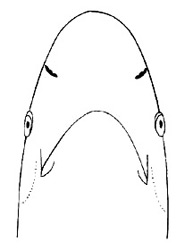
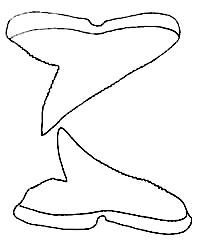
Dentition
Teeth are triangular with smooth-edged cusps, with a distinct notch along the outer margins. Weak serrations may be present in large individuals. The teeth are similar in both the upper and lower jaws, numbering 9-19 teeth in each. Back teeth in adult males tend to have taller, thin, and have flexed cusps (Compagno, 1984).
Denticles
Small and overlapping, blades are as broad as long with 3-5 keels. The posterior margin has the same number of teeth with the median tooth slightly longer than the others.
Size, Age, and Growth
The maximum reported size is 110 cm (43 in.) total length (Compagno, 1984). However, the average size of this shark is approximately 80 cm (31 inches) in length. Males reach sexual maturity at 65-70 cm (26-28 in.) TL and females are mature at 65 cm (26 in.) both being approximately 2 years old. Males mature faster, as shown by vertebrae analysis. Oldest specimens recorded are 8 years old, but they have been speculated to live as long as 10 (Mattos et al., 2001; Mattos et al., 2002; Montealegre, 2002).
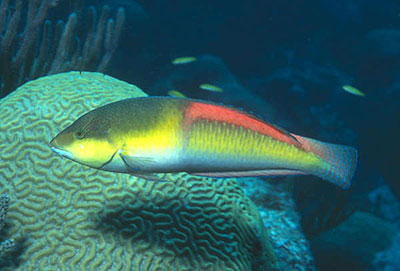
Food Habits
Small bony fishes, as well as marine invertebrates such as squid and crustaceans (da Silva and da Silva de Almeida, 2001).
Reproduction
They are viviparous, utilizing a yolksac placenta. It is believed that mating occurs during late winter until early summer followed by a gestation period of approximately 10 to 11 months. In Brazilian waters, birth occurs during the spring and early summer months. The litter size is 2-6 pups, with each pup measuring 12-15 inches (31-39 cm) in length (Compagno, 1984). There does appear to be an unequal biased towards female pups, the reason for this is currently unknown (Mattos et al., 2001). Migration and mating behaviors are still in need of research.
Predators
Large sharks are potential predators, especially of juveniles.
Taxonomy
The Caribbean sharpnose shark was first described as Squalus porosus by Cuban naturalist Felipe Poey (1861). This name was later changed to the currently valid name of Rhizoprionodon porosus (Poey, 1861). The genus name Rhizoprionodon is derived from the Greek, “rhiza” = root, “prion” = saw, and “odous” = teeth. There are no known synonyms referring to this species in past scientific literature.
Revised by: Tyler Bowling 2019
Prepared by: Cathleen Bester
References
- Compagno, L.J., 1984. Sharks of the world: an annotated and illustrated catalogue of shark species known to date (Vol. 4). Part 2. Carcharhiniformes. Food & Agriculture Org.
- Da Silva, C.M.L. and Da Silva de Almeida, Z. 2001. Alimentacao de Rhizoprionodon porosus (Elasmobranchii: Carcharhinidae) da costa do Maranhão, Brasil. Boletim do Instituto de Pesca (Sao Paulo) 27(2): 201–207.
- Mattos, S.M.G., Broadhurst, M.K., Hazin, F.H.V. and Jonnes, D.M. 2001. Reproductive biology of the Caribbean sharpnose shark, Rhizoprionodon porosus, from northern Brazil. Marine and Freshwater Research 52: 745–752.
- Mattos, S.M.G. and Pereira, J.A. 2002. Parametros de crescimento do tubarao rabo-seco, Rhizoprionodon porosus (Poey, 1861), no litoral de Estado de Pernambuco, Brasil. Arquivos de Ciencias do Mar 35: 57–66.
- Montealegre, S.Q. 2002. Idade, crescimento e analise demografica do cação Rhizoprionodon porosus (Poey, 1961) (Elasmobranchii: Carcharhinidae) na plataforma continental do Estado de Pernambuco, Brasil. Thesis. Universidade Federal de Pernambuco